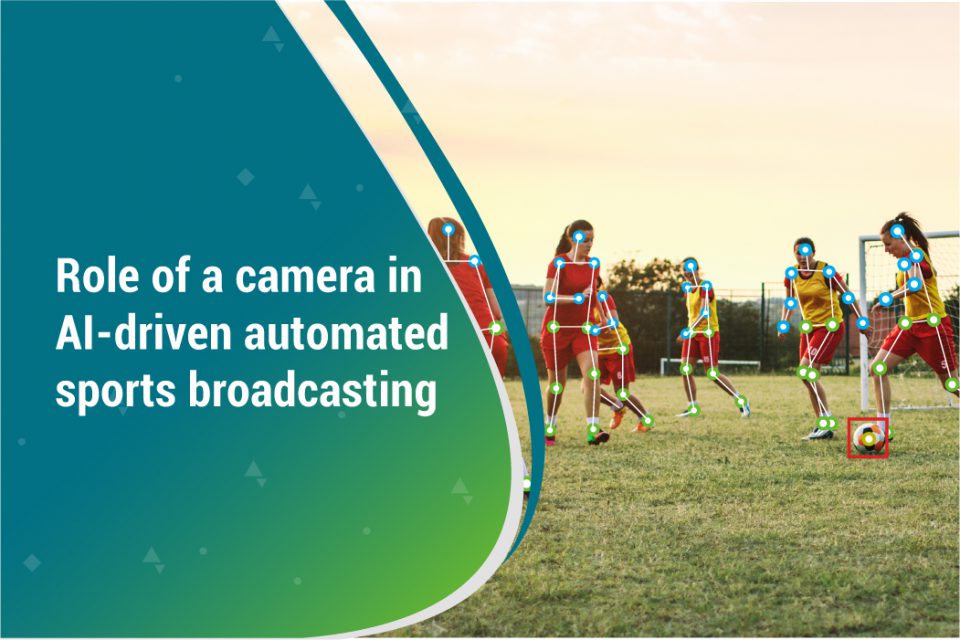Automated AI based sports broadcasting and analytics has been gaining great popularity in the recent years. With more and more companies coming up with automated sports broadcasting systems, the scope of use cases these devices can cover is also widening. From capturing and broadcasting soccer to golf to basketball matches, there are new use cases emerging every day.
Cameras and embedded vision technology are the heart of any automated sports broadcasting system. Are you wondering what the functions of a camera in such a system are? Do you know whether these cameras are the same as the ones used in professional sports broadcasting?
In this blog, we attempt to answer predominantly these two questions.
What is automated AI-driven sports broadcasting?
Before we look at the role of a camera, we need to understand what AI driven automated sports broadcasting is. To many, the concept still remains unclear.
Automated sports broadcasting as a term broadly means streaming and broadcasting live sports matches without the help of field operators or crew. Unlike professional sports broadcasting which needs an army of people to operate the camera and associated systems, automated sports broadcasting relies on cameras deployed on the field that automatically sends a feed to be telecast on TV or a streaming platform. These systems do not need any field personnel, and can work reliably during any time of the day irrespective of the weather conditions. Typically, these devices are installed to stream amateur sports matches which cannot afford to have a costly setup to capture them.
Now, where does AI or artificial intelligence come into picture?
While live streaming helps parents, friends, and fans watch amateur matches at the convenience of their homes, AI helps coaches and team managers to evaluate the performance of players and their team, and analyse the tactics of the opponent teams. A video analysis platform developed using AI algorithms helps to analyse match videos to give insights including shot charts, heatmaps, and detailed player, team, and game statistics.
Role of cameras in automated sports broadcasting
Cameras predominantly play two roles in an AI driver sports broadcasting system:
- Streaming matches for live broadcasting and viewing
- Serving image and video data for processing and sports based analytics
Let us now look at each of them in detail.
Streaming matches for live broadcasting and viewing
An automated sports broadcasting system typically involves camera systems mounted on poles around the sports field to capture the complete view of a game. A single camera unit includes multiple cameras (usually 2 to 4 cameras) that work synchronously to capture live videos of a game. This video is sent to a live streaming platform which offers viewers an opportunity to watch a game without having to be physically present in the venue. For the venue owners, this acts as an avenue to increase the number of viewers and popularity of the amateur (or not so popular) tournaments they conduct.
The cameras used in these systems are embedded cameras or camera modules that interface with a host platform – such as NVIDIA Jetson, NXP, Qualcomm etc – for data processing purposes. The camera also comprises of an image sensor, lens, interface, and an ISP (Image Signal Processor).
Serving image and video data for processing and sports based analytics
For AI based sports analytics to deliver actionable insights, the camera system has to be robust enough to capture video data in a form that can be analysed by the algorithms. This requires cameras to have the following capabilities:
- 1080p or 4k streaming
- High dynamic range
- Multi camera support and 180 degree stitching
- IP rated enclosure
- Compatibility with embedded platforms
The right resolution enables the camera system to zoom in on a particular area of the field (say players, ball etc). High dynamic range ensures reliable video capture in changing lighting conditions. Multi camera support helps in synchronized operations while 180 degree stitching helps to capture the full view of the field. IP rated enclosures give protection against harsh outdoor weather conditions. Compatibility with embedded platforms is important for edge based processing and analysis. These features also contribute to an enhanced viewing experience.
To learn more about the camera related features of an automated sports broadcasting system and how to choose a camera for it, have a look at the article Choosing the right camera for automated sports broadcasting – everything you need to know.
Embedded vision in automated sports broadcasting – what the future holds
Most of the automated sports broadcasting solution providers work on a model where they install the devices free of cost for the venue owners. They generate revenue by charging a subscription fee for the live streaming services – from all viewers including parents, fans, team managers, and coaches – and the AI based analytics and insights – for coaches and team managers – they offer using the video analytics platform. Since the revenue depends on the kind of insights these platforms can provide, we are likely to see many more new gen AI based use cases emerging in sports analytics in the coming years. This will also require cameras to evolve to be able to capture videos in a form that can be analysed by the AI engine.
It is interesting to note that advancements in embedded vision have had a significant impact on the growth of the AI-driven automated sports broadcasting market. The ability to do edge based processing with the increase in computing power of processing platforms has also fuelled this growth. Just to put things in perspective, one of the leading providers of automated sports broadcasting solutions already had its system installed in about 6500 venues across the world as of March 2020. So automated sports broadcasting is here to stay and grow. And given that every one of these devices needs a camera, the future embedded vision holds in this segment is very shiny.
Get to know how e-con Systems helped a global amateur sports broadcaster automate soccer broadcasting and improve the viewing experience.
e-con Systems’ cameras for automated sports broadcasting
Following is a list of e-con cameras suitable for automated sports broadcasting systems:
- SurveilsQUAD – Sony IMX290 Synchronized Multi-Camera System for NVIDIA® Jetson AGX Xavier™ Developer Kit
- STEEReoCAM® – 2MP Stereo Camera for NVIDIA® Jetson Nano™/Jetson AGX Xavier™/Jetson™ TX2
- e-CAM83_CUMI415_MOD – Sony STARVIS™ IMX415 Low light Camera Module capable of streaming 4K @ 90 fps
- e-CAM22_CUXVR – Sony STARVIS™ IMX327 Ultra Low-Light Camera for NVIDIA® Jetson AGX Xavier™ developer kit
- SmarteCAM – IP66 AI-enabled ready to deploy smart camera with AWS partner device certification.
- See3CAM_CU81 – 4K HDR USB 3.1 Gen 1 camera based on the AR0821 CMOS color image sensor
- See3CAM_CU55 – 5MP USB 3.1 Gen 1 UVC Low Noise Camera
- See3CAM_CU135 – 4K USB Camera Board
- e-CAM22_CUNX – Sony® STARVIS™ IMX462 Ultra Low-Light Camera
- Multi-Camera solution with 180° image stitching – Jetson AGX Xavier
- e-CAM23_CUXVR – Sony® STARVIS™ IMX462 Ultra-low Light Camera
e-con Systems has already worked with multiple solution providers in the space, and has over a time developed a deep expertise in building camera solutions for AI-driven automated sports broadcasting systems.
See how e-con Systems enabled a European client to offer advanced soccer broadcasting solutions
Looking for help in choosing the right camera for your automated sports broadcasting system? Please write to us at camerasolutions@e-consystems.com.

Ranjith is a camera solution architect with over 16 years of experience in embedded product development, electronics design, and product solutioning. In e-con Systems, he has been responsible for building 100+ vision solutions for customers spanning multiple areas within retail including self service kiosks, access control systems, smart checkouts and carts, retail monitoring systems, and much more.




